Franklin D. Roosevelt
From Wikipedia, the free encyclopedia
Franklin D. Roosevelt | |
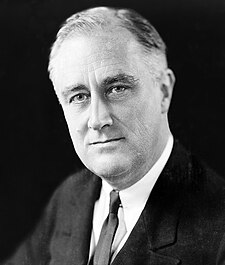 | |
| In office March 4, 1933 – April 12, 1945 | |
| Vice President | John N. Garner (1933–1941), Henry A. Wallace (1941–1945), Harry S. Truman (1945) |
| Preceded by | Herbert Hoover |
| Succeeded by | Harry S. Truman |
44th Governor of New York | |
| In office January 1, 1929 – December 31, 1932 | |
| Lieutenant | Herbert H. Lehman |
| Preceded by | Alfred E. Smith |
| Succeeded by | Herbert H. Lehman |
| In office 1913 – 1920 | |
| President | Woodrow Wilson |
Member of the New York Senate | |
| In office January 1, 1911 – March 17, 1913 | |
| Constituency | Dutchess County |
| Born | January 30, 1882(1882-01-30) Hyde Park, New York |
| Died | April 12, 1945 (aged 63) Warm Springs, Georgia |
| Birth name | Franklin Delano Roosevelt |
| Political party | Democratic |
| Spouse | Eleanor Roosevelt |
| Children | Anna Roosevelt Halsted James Roosevelt Franklin Delano Roosevelt, Jr. (I) Elliott Roosevelt Franklin Delano Roosevelt, Jr. John Aspinwall Roosevelt |
| Alma mater | Harvard University |
| Occupation | Lawyer (Corporate) |
| Religion | Episcopalian |
| Signature | |
Franklin Delano Roosevelt (January 30, 1882 – April 12, 1945), often referred to by his initials FDR, was the 32nd President of the United States. He was a central figure of the 20th century during a time of worldwide economic crisis and world war. Elected to four terms in office, he served from 1933 to 1945 and is the only U.S. president to have served more than two terms. Franklin D. Roosevelt and Theodore Roosevelt were fifth cousins but were close. FDR's wife Eleanor Roosevelt was Theodore's orphaned niece who he gave away in marriage to "cousin Franklin" in 1905.
During the Great Depression of the 1930s, Roosevelt created the New Deal to provide relief for the unemployed, recovery of the economy, and reform of the economic and banking systems, through various agencies, such as the Works Project Administration (WPA), National Recovery Administration (NRA), and the Agricultural Adjustment Administration (AAA).[1] Although recovery of the economy was incomplete until World War II, several programs he initiated, such as the Federal Deposit Insurance Corporation (FDIC), Tennessee Valley Authority (TVA), and the U.S. Securities and Exchange Commission (SEC), continue to have instrumental roles in the nation's commerce. Some of his other legacies include the Social Security system and the National Labor Relations Board (NLRB).
As Britain warred with the Axis nations, Roosevelt provided Lend-Lease aid to Winston Churchill and the British war effort before America's entry into World War II in December, 1941. On the home front, he introduced price controls and rationing. After the attack on Pearl Harbor by forces of the Japanese Empire and after the declaration of war on the United States by Nazi Germany and by Fascist Italy, Roosevelt introduced internment of Japanese Americans, German Americans, and Italian Americans.
Roosevelt led the United States as it became the 'Arsenal of Democracy'. Roosevelt, working closely with his aide Harry Hopkins, made the United States the principal arms supplier and financier of the Allies. America had a vast expansion of industry, the achievement of full employment, and new opportunities opened for African Americans and women. The new Conservative coalition, arguing disappearing unemployment, closed most relief programs like the Works Progress Administration (WPA) and Civilian Conservation Corps. As the Allies neared victory, Roosevelt played a critical role in shaping the post-war world, particularly through the Yalta Conference and the creation of the United Nations. Later, alongside the United States, the Allies defeated Germany, Italy, and Japan.
Roosevelt's election to the presidency brought about a realignment political scientists call the Fifth Party System. His aggressive use of the federal government created a New Deal coalition which dominated the Democratic Party until the late 1960s. Roosevelt introduced new taxes that affected all income groups. Conservatives vehemently fought back, but Roosevelt usually prevailed until he tried to pack the Supreme Court in 1937. He and his wife, Eleanor Roosevelt, remain touchstones for modern American liberalism. Roosevelt's administration redefined American liberalism and realigned the Democratic Party based on his New Deal coalition of labor unions; farmers; ethnic, religious and racial minorities; intellectuals;[2] the South; big city machines; and the poor and workers on relief. Roosevelt has been consistently ranked by scholars as one of the greatest U.S. Presidents.
Personal life
The family name
Roosevelt is an anglicized form of the Dutch surname 'van Rosevelt,' or 'van Rosenvelt', meaning 'field of roses.'[3] Although some use an Anglicized spelling pronunciation of IPA: /ˈruːzəvɛlt/, that is, with the vowels of rue and felt, Franklin used [ˈroʊzəvəlt], with the vowel of the English rose.[citation needed]
One of the wealthiest and oldest families in New York State, the Roosevelts distinguished themselves in areas other than politics. Franklin's first cousin, Ellen Roosevelt, was the 1890 U.S. Open Championships women's singles and doubles tennis champion and is a member of the International Tennis Hall of Fame.
His mother named him after her favorite uncle Franklin Delano.[4] The progenitor of the Delano family in the Americas of 1621 was Philippe de la Noye, the first Huguenot to land in the New World, whose family name was anglicized to Delano.[5]
Early life
Franklin Delano Roosevelt was born on January 30, 1882 in the Hudson Valley town of Hyde Park, New York. His father, James Roosevelt, and his mother, Sara, were each from wealthy old New York families, of Dutch and French ancestry respectively. Franklin was their only child. His paternal grandmother, Mary Rebecca Aspinwall, was a first cousin of Elizabeth Monroe, wife of the fifth U.S. President, James Monroe. One of his ancestors was John Lothropp, also an ancestor of Benedict Arnold and Joseph Smith, Jr. One of his distant relatives from his mother's side is the author Laura Ingalls Wilder. His maternal grandfather Warren Delano II, a descendant of Mayflower passengers Richard Warren, Isaac Allerton, Degory Priest, and Francis Cooke, during a period of twelve years in China made more than a million dollars in the tea trade in Macau, Canton, and Hong Kong, but upon returning to the United States, he lost it all in the Panic of 1857. In 1860, he returned to China and made a fortune in the notorious but highly profitable opium trade[6] supplying opium-based medication to the U. S. War Department during the American Civil War but not exclusively.[7]
Roosevelt grew up in an atmosphere of privilege. Sara was a possessive mother, while James was an elderly and remote father (he was 54 when Franklin was born). Sara was the dominant influence in Franklin's early years.[8] Frequent trips to Europe made Roosevelt conversant in German and French. He learned to ride, shoot, row, and play polo and lawn tennis.
Roosevelt went to Groton School, an Episcopal boarding school in Massachusetts. He was heavily influenced by its headmaster, Endicott Peabody, who preached the duty of Christians to help the less fortunate and urged his students to enter public service. Roosevelt went to Harvard, where he lived in luxurious quarters and was a member of the Alpha Delta Phi fraternity. He was also president of The Harvard Crimson daily newspaper. While he was at Harvard, his fifth cousin Theodore Roosevelt became president, and Theodore's vigorous leadership style and reforming zeal made him Franklin's role model and hero. In 1902, he met his future wife Eleanor Roosevelt, Theodore's niece, at a White House reception (they had previously met as children, but this was their first serious encounter). Eleanor and Franklin were fifth cousins, once removed.[9] They were both descended from Claes Martensz van Rosenvelt (Roosevelt), who arrived in New Amsterdam (Manhattan) from the Netherlands in the 1640s. Roosevelt's two grandsons, Johannes and Jacobus, began the Long Island and Hudson River branches of the Roosevelt family, respectively. Eleanor and Theodore Roosevelt were descended from the Johannes branch, while FDR came from the Jacobus branch.[9]
Roosevelt entered Columbia Law School in 1905, but dropped out (never to graduate) in 1907 because he had passed the New York State Bar exam. In 1908, he took a job with the prestigious Wall Street firm of Carter Ledyard & Milburn, dealing mainly with corporate law.
Marriage and family life
On March 17, 1905, Roosevelt married Eleanor despite the fierce resistance of his mother. Eleanor's uncle, Theodore Roosevelt, stood in at the wedding for Eleanor's deceased father Elliott. The young couple moved into Springwood, his family's estate, where FDR's mother became a frequent house guest, much to Eleanor's chagrin. Franklin was a charismatic, handsome, and socially active man. In contrast, Eleanor was shy and disliked social life, and at first stayed at home to raise their children. They had six children in rapid succession:
- Anna Eleanor (1906–1975; age 69)
- James (1907–1991; age 84)
- Franklin Delano, Jr. (March 3, 1909–November 7, 1909; age 249 days)
- Elliott (1910–1990; age 80)
- a second Franklin Delano, Jr. (1914–1988; age 74)
- John Aspinwall (1916–1981; age 65).
Roosevelt had affairs outside his marriage, including one with Eleanor's social secretary Lucy Mercer which began soon after she was hired in early 1914. In September 1918, Eleanor found letters revealing the affair in Roosevelt's luggage, when he returned from World War I. According to the Roosevelt family, Eleanor offered Franklin a divorce so that he could be with the woman he loved, but Lucy, being Catholic, could not bring herself to marry a divorced man with five children. Lucy's relatives, on the other hand, maintain that she wanted to marry Franklin but that "Eleanor was not willing to step aside." According to FDR's biographer Jean Edward Smith it is generally accepted that Eleanor indeed offered "to give Franklin his freedom."[10] However, they reconciled after a fashion with the informal mediation of Roosevelt's adviser Louis McHenry Howe, and FDR promised never to see Lucy again. Sara also intervened, and told Franklin that if he divorced his wife, he would bring scandal upon the family, and she "would not give him another dollar."[10] Eleanor established a separate house in Hyde Park at Valkill. Their marriage has been labeled a "marriage of convenience."[11]
Franklin and Lucy maintained a formal correspondence, but they did not begin to see each other again until 1941. Lucy was then given the code name "Mrs. Johnson" by the Secret Service.[12] Not until the 1960s was the affair publicly known.
In 1919 the Roosevelts lived next door to Attorney General A. Mitchell Palmer, and were present when a Galleanist anarchist was killed in the botched bombing that was an attempt to assassinate Palmer. Also in 1919, Franklin Roosevelt helped Éamon de Valera and his fledgling Irish Republican Army get around export laws for shipping arms used against British troops in the Irish War of Independence.
The five surviving Roosevelt children all led tumultuous lives overshadowed by their famous parents. They had among them nineteen marriages, fifteen divorces, and twenty-nine children. All four sons were officers in World War II and were decorated, on merit, for bravery. Two of them were elected to the U.S. House of Representatives—FDR, Jr. served three terms representing the Upper West Side of Manhattan, and James served six terms representing the 26th district in California—but none were elected to higher office despite several attempts.[13][14][15][16]
Roosevelt's dog, Fala, also became well-known as a companion of Roosevelt's during his time in the White House, and was called the "most photographed dog in the world."[17]
Early political career
State Senator
In 1910, Roosevelt ran for the New York State Senate from the district around Hyde Park in Dutchess County, which had not elected a Democrat since 1884. He entered the Roosevelt name, with its associated wealth, prestige, and influence in the Hudson Valley, and the Democratic landslide that year carried him to the state capital of Albany, New York. Roosevelt entered the state house, January 1, 1911. He became a leader of a group of reformers who opposed Manhattan's Tammany Hall machine which dominated the state Democratic Party. Roosevelt soon became a popular figure among New York Democrats. He was reelected for a second term November 5, 1912, and resigned from the New York State Senate on March 17, 1913.[18][19]
Assistant Secretary of the Navy
Franklin D. Roosevelt was appointed Assistant Secretary of the Navy by Woodrow Wilson in 1913. He served under Secretary of the Navy Josephus Daniels. In 1914, he was defeated in the Democratic primary election for the United States Senate by Tammany Hall-backed James W. Gerard. As assistant secretary, Roosevelt worked to expand the Navy and founded the United States Navy Reserve. Wilson sent the Navy and Marines to intervene in Central American and Caribbean countries. In a series of speeches in his 1920 campaign for Vice President, Roosevelt claimed that he, as Assistant Secretary of the Navy, wrote the constitution which the U.S. imposed on Haiti in 1915.[20]
Roosevelt developed a life-long affection for the Navy. Roosevelt negotiated with Congressional leaders and other government departments to get budgets approved. He became an enthusiastic advocate of the submarine and also of means to combat the German submarine menace to Allied shipping: he proposed building a mine barrier across the North Sea from Norway to Scotland. In 1918, he visited Britain and France to inspect American naval facilities; during this visit he met Winston Churchill for the first time. With the end of World War I in November 1918, he was in charge of demobilization, although he opposed plans to completely dismantle the Navy. In July 1920, Roosevelt resigned as Assistant Secretary of the Navy.
Campaign for Vice-President
The 1920 Democratic National Convention chose Roosevelt as the candidate for Vice President of the United States on the ticket headed by Governor James M. Cox of Ohio, helping build a national base, but the Cox-Roosevelt ticket was heavily defeated by Republican Warren G. Harding in the presidential election. Roosevelt then retired to a New York legal practice and joined the newly-organized New York Civitan Club,[21] but few doubted that he would soon run for public office again.
Paralytic illness
In August 1921, while the Roosevelts were vacationing at Campobello Island, New Brunswick, Roosevelt contracted an illness, at the time believed to be polio, which resulted in his total and permanent paralysis from the waist down. For the rest of his life, Roosevelt refused to accept that he was permanently paralyzed. He tried a wide range of therapies, including hydrotherapy, and, in 1926, he purchased a resort at Warm Springs, Georgia, where he founded a hydrotherapy center for the treatment of polio patients which still operates as the Roosevelt Warm Springs Institute for Rehabilitation. After he became President, he helped to found the National Foundation for Infantile Paralysis (now known as the March of Dimes). His leadership in this organization is one reason he is commemorated on the dime.[22][23]
At the time, Roosevelt was able to convince many people that he was in fact getting better, which he believed was essential if he was to run for public office again. Fitting his hips and legs with iron braces, he laboriously taught himself to walk a short distance by swiveling his torso while supporting himself with a cane. In private, he used a wheelchair, but he was careful never to be seen in it in public. He usually appeared in public standing upright, supported on one side by an aide or one of his sons.
In 2003, a peer-reviewed study found that it was more likely that Roosevelt's paralytic illness was actually Guillain-Barré syndrome, not poliomyelitis.[24]
Governor of New York, 1929–1932
Roosevelt maintained contacts and mended fences with the Democratic Party during the 1920s, especially in New York. Although he made his name as an opponent of New York City's Tammany Hall machine, Roosevelt moderated his stance. He helped Alfred E. Smith win the election for governor of New York in 1922. Roosevelt gave nominating speeches for Smith at the 1924 and 1928 Democratic conventions.[25] In 1928, as the Democratic Party presidential nominee in the 1928 election, Smith in turn asked Roosevelt to run for governor. While Smith lost the Presidency in a landslide, and was even defeated in his home state, Roosevelt was narrowly elected governor.
As a reform governor, he established a number of new social programs, and he was advised by Frances Perkins and Harry Hopkins.
In the 1930 election campaign, to be re-elected, Roosevelt needed the good will of the Tammany Hall machine in New York City; however, his Republican opponent, Charles H. Tuttle, was using Tammany Hall's corruption as an election issue. As the election approached, Roosevelt initiated investigations of the sale of judicial offices. He was elected to a second term by a margin of more than 700,000 votes.[26]
Boy Scout supporter
Roosevelt was a strong supporter of scouting, beginning in 1915. In 1924, he became president of the New York City Boy Scout Foundation and led the development of Ten Mile River Boy Scout Camp between 1924–1928 to serve the Scouts of New York City.[27] As governor in 1930, the Boy Scouts of America (BSA) honored him with their highest award for adults, the Silver Buffalo Award, which is conferred in recognition of distinguished support of youth on a national level.[28] Later, as U.S. president, Roosevelt was honorary president of the BSA and attended the first national jamboree in Washington, D.C. in 1937.[29]
1932 presidential election
Roosevelt's strong base in the most populous state made him an obvious candidate for the Democratic nomination, which was hotly contested since it seemed that incumbent Herbert Hoover would be vulnerable in the 1932 election. Al Smith was supported by some city bosses, but had lost control of the New York Democratic party to Roosevelt. Roosevelt built his own national coalition with personal allies such as newspaper magnate William Randolph Hearst, Irish leader Joseph P. Kennedy, Sr., and California leader William Gibbs McAdoo. When Texas leader John Nance Garner switched to FDR, he was given the presidential nomination.
In his acceptance speech, Roosevelt declared:
| “ | Throughout the nation men and women, forgotten in the political philosophy of the Government, look to us here for guidance and for more equitable opportunity to share in the distribution of national wealth... I pledge you, I pledge myself to a new deal for the American people... This is more than a political campaign. It is a call to arms.[30] | ” |
The election campaign was conducted under the shadow of the Great Depression in the United States, and the new alliances which it created. Roosevelt and the Democratic Party mobilized the expanded ranks of the poor as well as organized labor, ethnic minorities, urbanites, and Southern whites, crafting the New Deal coalition. During the campaign, Roosevelt said: "I pledge you, I pledge myself, to a new deal for the American people", coining a slogan that was later adopted for his legislative program as well as his new coalition.[31]
Economist Marriner Eccles observed that "given later developments, the campaign speeches often read like a giant misprint, in which Roosevelt and Hoover speak each other's lines."[32] Roosevelt denounced Hoover's failures to restore prosperity or even halt the downward slide, and he ridiculed Hoover's huge deficits. Roosevelt campaigned on the Democratic platform advocating "immediate and drastic reductions of all public expenditures," "abolishing useless commissions and offices, consolidating bureaus and eliminating extravagances reductions in bureaucracy," and for a "sound currency to be maintained at all hazards." On September 23, Roosevelt made the gloomy evaluation that, "Our industrial plant is built; the problem just now is whether under existing conditions it is not overbuilt. Our last frontier has long since been reached."[33] Hoover damned that pessimism as a denial of "the promise of American life ... the counsel of despair."[34] The prohibition issue solidified the wet vote for Roosevelt, who noted that repeal would bring in new tax revenues.
Roosevelt won 57% of the vote and carried all but six states. Historians and political scientists consider the 1932-36 elections a realigning election that created a new majority coalition for the Democrats, thus transforming American politics and starting what is called the "New Deal Party System" or (by political scientists) the Fifth Party System.[35]
After the election, Roosevelt refused Hoover's requests for a meeting to come up with a joint program to stop the downward spiral and calm investors, claiming it would tie his hands. The economy spiralled downward until the banking system began a complete nationwide shutdown as Hoover's term ended.[36] In February 1933, Roosevelt escaped an assassination attempt by Giuseppe Zangara (which killed Chicago Mayor Anton Cermak sitting next to him).[37] Roosevelt leaned heavily on his "Brain Trust" of academic advisors, especially Raymond Moley when designing his policies; he offered cabinet positions to numerous candidates (sometimes two at a time), but most declined. The cabinet member with the strongest independent base was Cordell Hull at State. William Hartman Woodin at Treasury, was soon replaced by the much more powerful Henry Morgenthau, Jr.[38]
First term, 1933–1937
When Roosevelt was inaugurated in March 1933, the U.S. was at the nadir of the worst depression in its history. A quarter of the workforce was unemployed. Farmers were in deep trouble as prices fell by 60%. Industrial production had fallen by more than half since 1929. Two million were homeless. By the evening of March 4, 32 of the 48 states, as well as the District of Columbia had closed their banks.[39] The New York Federal Reserve Bank was unable to open on the 5th, as huge sums had been withdrawn by panicky customers in previous days.[40] Beginning with his inauguration address, Roosevelt began blaming the economic crisis on bankers and financiers, the quest for profit, and the self-interest basis of capitalism:
| “ | Primarily this is because rulers of the exchange of mankind's goods have failed through their own stubbornness and their own incompetence, have admitted their failure, and have abdicated. Practices of the unscrupulous money changers stand indicted in the court of public opinion, rejected by the hearts and minds of men. True they have tried, but their efforts have been cast in the pattern of an outworn tradition. Faced by failure of credit they have proposed only the lending of more money. Stripped of the lure of profit by which to induce our people to follow their false leadership, they have resorted to exhortations, pleading tearfully for restored confidence....The money changers have fled from their high seats in the temple of our civilization. We may now restore that temple to the ancient truths. The measure of the restoration lies in the extent to which we apply social values more noble than mere monetary profit.[41] | ” |
Historians categorized Roosevelt's program as "relief, recovery and reform." Relief was urgently needed by tens of millions of unemployed. Recovery meant boosting the economy back to normal. Reform meant long-term fixes of what was wrong, especially with the financial and banking systems. Roosevelt's series of radio talks, known as fireside chats, presented his proposals directly to the American public.[42]
First New Deal, 1933–1934
Roosevelt's "First 100 Days" concentrated on the first part of his strategy: immediate relief. From March 9 to June 16, 1933, he sent Congress a record number of bills, all of which passed easily. To propose programs, Roosevelt relied on leading Senators such as George Norris, Robert F. Wagner and Hugo Black, as well as his Brain Trust of academic advisers. Like Hoover, he saw the Depression caused in part by people no longer spending or investing because they were afraid.
His inauguration on March 4, 1933 occurred in the middle of a bank panic, hence the backdrop for his famous words: "The only thing we have to fear is fear itself."[43] The very next day Congress passed the Emergency Banking Act which declared a "bank holiday" and announced a plan to allow banks to reopen. However, the number of banks that opened their doors after the "holiday" was less than the number that had been open before.[44] This was his first proposed step to recovery. To give Americans confidence in the banks, Roosevelt signed the Glass-Stegall Act that created the Federal Deposit Insurance Corporation.

Dorothea Lange's Migrant Mother depicts destitute pea pickers during the depression in California, centering on Florence Owens Thompson, a mother of seven children at age 32, March 1936.
- Relief measures included the continuation of Hoover's major relief program for the unemployed under the new name, Federal Emergency Relief Administration. The most popular of all New Deal agencies, and Roosevelt's favorite, was the Civilian Conservation Corps (CCC), which hired 250,000 unemployed young men to work on rural local projects. Congress also gave the Federal Trade Commission broad new regulatory powers and provided mortgage relief to millions of farmers and homeowners. Roosevelt expanded a Hoover agency, the Reconstruction Finance Corporation, making it a major source of financing to railroads and industry. Roosevelt made agriculture relief a high priority and set up the first Agricultural Adjustment Administration (AAA). The AAA tried to force higher prices for commodities by paying farmers to take land out of crops and to cut herds.
- Reform of the economy was the goal of the National Industrial Recovery Act (NIRA) of 1933. It tried to end cutthroat competition by forcing industries to come up with codes that established the rules of operation for all firms within specific industries, such as minimum prices, agreements not to compete, and production restrictions. Industry leaders negotiated the codes which were then approved by NIRA officials. Industry needed to raise wages as a condition for approval. Provisions encouraged unions and suspended anti-trust laws. The NIRA was found to be unconstitutional by unanimous decision of the U.S. Supreme Court on May 27, 1935. Roosevelt opposed the decision, saying "The fundamental purposes and principles of the NIRA are sound. To abandon them is unthinkable. It would spell the return to industrial and labor chaos."[45] In 1933, major new banking regulations were passed. In 1934, the Securities and Exchange Commission was created to regulate Wall Street, with 1932 campaign fundraiser Joseph P. Kennedy in charge.
- Recovery was pursued through "pump-priming" (that is, federal spending). The NIRA included $3.3 billion of spending through the Public Works Administration to stimulate the economy, which was to be handled by Interior Secretary Harold Ickes. Roosevelt worked with Republican Senator George Norris to create the largest government-owned industrial enterprise in American history, the Tennessee Valley Authority (TVA), which built dams and power stations, controlled floods, and modernized agriculture and home conditions in the poverty-stricken Tennessee Valley. The repeal of prohibition also brought in new tax revenues and helped him keep a major campaign promise.
- In a controversial move, Roosevelt gave Executive Order 6102 which made all privately held gold of American citizens property of the US Treasury. This gold confiscation by executive order was argued to be unconstitutional, but Roosevelt's executive order asserts authority to do so based on the "War Time Powers Act" of 1917. Gold bullion remained illegal for Americans to own until President Ford rescinded the order in 1974.[46][47][48][49]
Roosevelt tried to keep his campaign promise by cutting the regular federal budget, including 40% cuts to veterans' benefits and cuts in overall military spending. He removed 500,000 veterans and widows from the pension rolls and slashed benefits for the remainder. Protests erupted, led by the Veterans of Foreign Wars. Roosevelt held his ground, but when the angry veterans formed a coalition with Senator Huey Long and passed a huge bonus bill over his veto, he was defeated. He succeeded in cutting federal salaries and the military and naval budgets. He reduced spending on research and education.
Roosevelt also kept his promise to push for repeal of Prohibition. In April 1933, he issued an Executive Order redefining 3.2% alcohol as the maximum allowed. That order was preceded by Congressional action in the drafting and passage of the 21st Amendment, which was ratified later that year.
Second New Deal, 1935–1936
After the 1934 Congressional elections, which gave Roosevelt large majorities in both houses, there was a fresh surge of New Deal legislation. These measures included the Works Progress Administration (WPA) which set up a national relief agency that employed two million family heads. However, even at the height of WPA employment in 1938, unemployment was still 12.5% according to figures from Michael Darby.[50] The Social Security Act, established Social Security and promised economic security for the elderly, the poor and the sick. Senator Robert Wagner wrote the Wagner Act, which officially became the National Labor Relations Act. The act established the federal rights of workers to organize unions, to engage in collective bargaining, and to take part in strikes.
While the First New Deal of 1933 had broad support from most sectors, the Second New Deal challenged the business community. Conservative Democrats, led by Al Smith, fought back with the American Liberty League, savagely attacking Roosevelt and equating him with Marx and Lenin.[51] But Smith overplayed his hand, and his boisterous rhetoric let Roosevelt isolate his opponents and identify them with the wealthy vested interests that opposed the New Deal, setting Roosevelt up for the 1936 landslide.[52] By contrast, the labor unions, energized by the Wagner Act, signed up millions of new members and became a major backer of Roosevelt's reelections in 1936, 1940 and 1944.[53]
Economic environment
Government spending increased from 8.0% of gross national product (GNP) under Hoover in 1932 to 10.2% of the GNP in 1936. Because of the depression, the national debt as a percentage of the GNP had doubled under Hoover from 16% to 33.6% of the GNP in 1932. While Roosevelt balanced the "regular" budget, the emergency budget was funded by debt, which increased to 40.9% in 1936, and then remained level until World War II, at which time it escalated rapidly. The national debt rose under Hoover, held steady under FDR until the war began, as shown on chart 1.[54]
Deficit spending had been recommended by some economists, most notably by John Maynard Keynes of Britain. Some economists in retrospect have argued that the National Labor Relations Act and Agricultural Adjustment Administration were ineffective policies because they relied on price fixing.[55] The GNP was 34% higher in 1936 than in 1932 and 58% higher in 1940 on the eve of war. That is, the economy grew 58% from 1932 to 1940 in 8 years of peacetime, and then grew 56% from 1940 to 1945 in 5 years of wartime. However, the economic recovery did not absorb all the unemployment Roosevelt inherited. Unemployment fell dramatically in Roosevelt's first term, from 25% when he took office to 14.3% in 1937. Afterward, however, it increased to 19.0% in 1938 ('a depression within a depression'), 17.2% in 1939 because of various added taxation (Undistributed profits tax in Mar. 1936, and the Social Security Payroll Tax 1937, plus the effects of the Wagner Act; the Fair Labor Standards Act and a blizzard of other federal regulations), and stayed high until it almost vanished during World War II when the previously unemployed were conscripted, taking them out of the potential labor supply number.[56]
During the war, the economy operated under such different conditions that comparison with peacetime is impossible. However, Roosevelt saw the New Deal policies as central to his legacy, and in his 1944 State of the Union Address, he advocated that Americans should think of basic economic rights as a Second Bill of Rights.
The U.S. economy grew rapidly during Roosevelt's term.[57] However, coming out of the depression, this growth was accompanied by continuing high levels of unemployment; as the median joblessness rate during the New Deal was 17.2%. Throughout his entire term, including the war years, average unemployment was 13%.[58][59] Total employment during Roosevelt's term expanded by 18.31 million jobs, with an average annual increase in jobs during his administration of 5.3%.[60]
Roosevelt did not raise income taxes before World War II began; however payroll taxes were also introduced to fund the new Social Security program in 1937. He also got Congress to spend more on many various programs and projects never before seen in American history. However, under the revenue pressures brought on by the depression, most states added or increased taxes, including sales as well as income taxes. Roosevelt's proposal for new taxes on corporate savings were highly controversial in 1936–37, and were rejected by Congress. During the war he pushed for even higher income tax rates for individuals (reaching a marginal tax rate of 91%) and corporations and a cap on high salaries for executives. In order to fund the war, Congress broadened the base so that almost every employee paid federal income taxes, and introduced withholding taxes in 1943.
| Unemployment (% labor force) | ||
| Year | Lebergott | Darby[61] |
| 1933 | 24.9 | 20.6 |
| 1934 | 21.7 | 16.0 |
| 1935 | 20.1 | 14.2 |
| 1936 | 16.9 | 9.9 |
| 1937 | 14.3 | 9.1 |
| 1938 | 19.0 | 12.5 |
| 1939 | 17.2 | 11.3 |
| 1940 | 14.6 | 9.5 |
| 1941 | 9.9 | 8.0 |
| 1942 | 4.7 | 4.7 |
| 1943 | 1.9 | 1.9 |
| 1944 | 1.2 | 1.2 |
| 1945 | 1.9 | 1.9 |
Foreign policy, 1933–37
The rejection of the League of Nations treaty in 1919 marked the dominance of isolationism from world organizations in American foreign policy. Despite Roosevelt's Wilsonian background, he and Secretary of State Cordell Hull acted with great care not to provoke isolationist sentiment. Roosevelt's "bombshell" message to the world monetary conference in 1933 effectively ended any major efforts by the world powers to collaborate on ending the worldwide depression, and allowed Roosevelt a free hand in economic policy.[62]
The main foreign policy initiative of Roosevelt's first term was the Good Neighbor Policy, which was a re-evaluation of U.S. policy towards Latin America. Since the Monroe Doctrine of 1823, this area had been seen as an American sphere of influence. American forces were withdrawn from Haiti, and new treaties with Cuba and Panama ended their status as United States protectorates. In December 1933, Roosevelt signed the Montevideo Convention on the Rights and Duties of States, renouncing the right to intervene unilaterally in the affairs of Latin American countries.[63]
Landslide re-election, 1936
In the 1936 presidential election, Roosevelt campaigned on his New Deal programs against Kansas Governor Alf Landon, who accepted much of the New Deal but objected that it was hostile to business and involved too much waste. Roosevelt and Garner won 60.8% of the vote and carried every state except Maine and Vermont. The New Deal Democrats won even larger majorities in Congress. Roosevelt was backed by a coalition of voters which included traditional Democrats across the country, small farmers, the "Solid South," Catholics, big city machines, labor unions, northern African Americans, Jews, intellectuals and political liberals. This coalition, frequently referred to as the New Deal coalition, remained largely intact for the Democratic Party until the 1960s.[64]
Second term, 1937–1941
In dramatic contrast to the first term, very little major legislation was passed in the second term. There was a United States Housing Authority (1937), a second Agricultural Adjustment Act and the Fair Labor Standards Act (FLSA) of 1938, which created the minimum wage. When the economy began to deteriorate again in late 1937, Roosevelt responded with an aggressive program of stimulation, asking Congress for $5 billion for WPA relief and public works. This managed to eventually create a peak of 3.3 million WPA jobs by 1938.
The Supreme Court was the main obstacle to Roosevelt's programs during his second term, overturning many of his programs. In particular in 1935 the Court unanimously ruled that the National Recovery Act (NRA) was an unconstitutional delegation of legislative power to the president. Roosevelt stunned Congress in early 1937 by proposing a law allowing him to appoint five new justices, a "persistent infusion of new blood."[65] This "court packing" plan ran into intense political opposition from his own party, led by Vice President Garner, since it seemed to upset the separation of powers and give the President control over the Court. Roosevelt's proposals were defeated. The Court also drew back from confrontation with the administration by finding the Labor Relations and Social Security Acts to be constitutional. Deaths and retirements on the Supreme Court soon allowed Roosevelt to make his own appointments to the bench with little controversy. Between 1937 and 1941, he appointed eight justices to the court.[66]
Roosevelt had massive support from the rapidly growing labor unions, but now they split into bitterly feuding AFL and CIO factions, the latter led by John L. Lewis. Roosevelt pronounced a "plague on both your houses," but the disunity weakened the party in the elections from 1938 through 1946.[67]
Determined to overcome the opposition of conservative Democrats in Congress (mostly from the South), Roosevelt involved himself in the 1938 Democratic primaries, actively campaigning for challengers who were more supportive of New Deal reform. His targets denounced Roosevelt for trying to take over the Democratic party and used the argument that they were independent to win reelection. Roosevelt failed badly, managing to defeat only one target, a conservative Democrat from New York City.[68]
In the November 1938 election, Democrats lost six Senate seats and 71 House seats. Losses were concentrated among pro-New Deal Democrats. When Congress reconvened in 1939, Republicans under Senator Robert Taft formed a Conservative coalition with Southern Democrats, virtually ending Roosevelt's ability to get his domestic proposals enacted into law. The minimum wage law of 1938 was the last substantial New Deal reform act passed by Congress.[69]
Foreign policy, 1937–1941

President Roosevelt welcomed President Manuel L. Quezon, the 2nd President of the Philippines, in Washington, D.C.
The rise to power of dictator Adolf Hitler in Germany aroused fears of a new world war. In 1935, at the time of Italy's invasion of Ethiopia, Congress passed the Neutrality Act, applying a mandatory ban on the shipment of arms from the U.S. to any combatant nation. Roosevelt opposed the act on the grounds that it penalized the victims of aggression such as Ethiopia, and that it restricted his right as President to assist friendly countries, but public support was overwhelming so he signed it. In 1937, Congress passed an even more stringent act, but when the Sino-Japanese War broke out in 1937, public opinion favored China, and Roosevelt found various ways to assist that nation.[70]
In October 1937, he gave the Quarantine Speech aiming to contain aggressor nations. He proposed that warmongering states be treated as a public health menace and be "quarantined."[71] Meanwhile he secretly stepped up a program to build long range submarines that could blockade Japan.
In May 1938, there occurred a failed coup by the fascist Integralista movement in Brazil. After the failed coup, the Brazilian government claimed that the German Ambassador, Dr. Karl Ritter had been involved in the coup attempt and declared him persona non grata. The Brazilian allegation of German support for the Integralista coup had a galvanizing impact on the Roosevelt administration as it led to fears that German ambitions were not confined to Europe, but rather to the whole world. This in turn led the Roosevelt administration to change its previous view of the Nazi regime as an unpleasant regime that was however basically not an American problem.
On September 4, 1938 in the midst of the great crisis in Europe that was to culminate in the Munich Agreement, during the unveiling of a plaque in France honoring Franco-American friendship, the American Ambassador, and close friend of Roosevelt’s William C. Bullitt stated that "France and the United States were united in war and peace," leading to much speculation in the press that if war did break over Czechoslovakia, then the United States would join the war on the Allied side.[72] Roosevelt disallowed this interpretation of Bullitt’s remarks in a press conference on September 9, stating it was “100% wrong” the U.S. would join a “stop-Hitler bloc” under any circumstances, and made it quite clear in the event of German aggression against Czechoslovakia, the U.S. would remain neutral.[72] Upon Neville Chamberlain’s return to London from the Munich Conference, Roosevelt sent him a two word telegram reading “Good Man”, which has been the subject of much debate, with the majority opinion arguing that the telegram was meant to be congratulatory with the minority opinion opposing that interpretation.[73]
In October 1938, Roosevelt opened secret talks with the French on how to bypass American neutrality laws and allowed the French to buy American aircraft to make up for productivity deficiencies in the French aircraft industry.[74] The French Premier Édouard Daladier commented in October 1938 that "If I had three or four thousand aircraft Munich would never have happened", and was most anxious to buy American war planes as the only way of strengthening the French Air Force.[75] A major problem in the Franco-American talks was how the French were to pay for the American planes, and how to bypass the American neutrality acts[76] In addition, the American Johnson Act of 1934 which forbade loans to the nations that had defaulted on their World War I debts was a further complicating factor (France had defaulted on its World War I debts in 1932).[77] In February 1939, the French offered to cede their possessions in the Caribbean and the Pacific together with a lump sum payment of ten billion francs, in exchange for the unlimited right to buy on credit American aircraft.[78] After torturous negotiations, an arrangement was worked out in the spring of 1939 allowing the French to place huge orders with the American aircraft industry; though most of the aircraft ordered had not arrived in France by 1940, Roosevelt arranged for French orders to be diverted to the British.[79]
When World War II broke out in 1939, Roosevelt rejected the Wilsonian neutrality stance and sought ways to assist Britain and France militarily. He began a regular secret correspondence with the First Lord of Admiralty Winston Churchill in September 1939 discussing ways of supporting Britain. Roosevelt forged a close personal relationship with Churchill, who became Prime Minister of the UK in May 1940.
In April 1940 Germany invaded Denmark and Norway, followed by invasions of the Netherlands, Belgium, Luxembourg, and France in May. The German victories in Western Europe left Britain vulnerable to invasion. Roosevelt, who was determined that Britain not be defeated, took advantage of the rapid shifts of public opinion. The fall of Paris shocked American opinion, and isolationist sentiment declined. A consensus was clear that military spending had to be dramatically expanded. There was no consensus on how much the U.S. should risk war in helping Britain. In July 1940, FDR appointed two interventionist Republican leaders, Henry L. Stimson and Frank Knox, as Secretaries of War and the Navy respectively. Both parties gave support to his plans to rapidly build up the American military, but the isolationists warned that Roosevelt would get the nation into an unnecessary war with Germany. He successfully urged Congress to enact the first peacetime draft in United States history in 1940 (it was renewed in 1941 by one vote in Congress). Roosevelt was supported by the Committee to Defend America by Aiding the Allies, and opposed by the America First Committee.[80]
Roosevelt used his personal charisma to build support for intervention. America should be the "Arsenal of Democracy," he told his fireside audience.[81] On September 2, 1940, Roosevelt openly defied the Neutrality Acts by passing the Destroyers for Bases Agreement, which gave 50 American destroyers to Britain in exchange for military base rights in the British Caribbean islands and Newfoundland. This was a precursor of the March 1941 Lend-Lease agreement which began to direct massive military and economic aid to Britain, the Republic of China, and later the Soviet Union. For foreign policy advice, Roosevelt turned to Harry Hopkins, who became his chief wartime advisor. They sought innovative ways to help Britain, whose financial resources were exhausted by the end of 1940. Congress, where isolationist sentiment was in retreat, passed the Lend-Lease Act in March 1941, allowing the U.S. to give Britain, China and later the Soviet Union military supplies. Congress voted to commit to spend $50 billion on military supplies from 1941–45. In sharp contrast to the loans of World War I, there would be no repayment after the war. Roosevelt was a lifelong free trader and anti-imperialist, and ending European colonialism was one of his objectives.
Third term, 1941–1945
Election of 1940
The two-term tradition had been an unwritten rule (until the 22nd Amendment after his presidency) since George Washington declined to run for a third term in 1796, and both Ulysses S. Grant and Theodore Roosevelt were attacked for trying to obtain a third non-consecutive term. FDR systematically undercut prominent Democrats who were angling for the nomination, including two cabinet members, Secretary of State Cordell Hull and James Farley, Roosevelt's campaign manager in 1932 and 1936, Postmaster General and Democratic Party chairman. Roosevelt moved the convention to Chicago where he had strong support from the city machine (which controlled the auditorium sound system). At the convention the opposition was poorly organized but Farley had packed the galleries. Roosevelt sent a message saying that he would not run, unless he was drafted, and that the delegates were free to vote for anyone. The delegates were stunned; then the loudspeaker screamed "We want Roosevelt... The world wants Roosevelt!" The delegates went wild and he was nominated by 946 to 147. The new vice presidential nominee was Henry A. Wallace, the liberal intellectual who was Secretary of Agriculture.[82]
In his campaign against Republican Wendell Willkie, Roosevelt stressed both his proven leadership experience and his intention to do everything possible to keep the United States out of war. He won the 1940 election with 55% of the popular vote and 38 of the 48 states. A shift to the left within the Administration was shown by the naming of Henry A. Wallace as Vice President in place of the conservative Texan John Nance Garner, who had become a bitter enemy of Roosevelt after 1937.
Policies
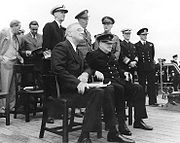
Roosevelt and Winston Churchill meet at Argentia, Newfoundland aboard HMS Prince of Wales during their 1941 secret meeting to develop the Atlantic Charter.
Roosevelt's third term was dominated by World War II, in Europe and in the Pacific. Roosevelt slowly began re-armament in 1938 since he was facing strong isolationist sentiment from leaders like Senators William Borah and Robert Taft who supported re-armament. By 1940, it was in high gear, with bipartisan support, partly to expand and re-equip the United States Army and Navy and partly to become the "Arsenal of Democracy" supporting the United Kingdom, French Third Republic, the Republic of China and (after June 1941), the Soviet Union. As Roosevelt took a firmer stance against the Axis Powers, American isolationists—including Charles Lindbergh and America First—attacked the President as an irresponsible warmonger. Unfazed by these criticisms and confident in the wisdom of his foreign policy initiatives, FDR continued his twin policies of preparedness and aid to the Allied coalition. On December 29, 1940, he delivered his Arsenal of Democracy fireside chat, in which he made the case for involvement directly to the American people, and a week later he delivered his famous Four Freedoms speech in January 1941, further laying out the case for an American defense of basic rights throughout the world.
The military buildup spurred economic growth. By 1941, unemployment had fallen to under 1 million. There was a growing labor shortage in all the nation's major manufacturing centers, accelerating the Great Migration of African Americans workers from the Southern United States, and of underemployed farmers and workers from all rural areas and small towns. The homefront was subject to dynamic social changes throughout the war, though domestic issues were no longer Roosevelt's most urgent policy concerns.
When Nazi Germany invaded the Soviet Union in June 1941, Roosevelt extended Lend-Lease to the Soviets. During 1941, Roosevelt also agreed that the U.S. Navy would escort Allied convoys as far east as Great Britain and would fire upon German ships or submarines (U-boats) of the Kriegsmarine if they attacked Allied shipping within the U.S. Navy zone. Moreover, by 1941, U.S. Navy aircraft carriers were secretly ferrying British fighter planes between the UK and the Mediterranean war zones, and the British Royal Navy was receiving supply and repair assistance at American naval bases in the United States.
Thus, by mid-1941, Roosevelt had committed the U.S. to the Allied side with a policy of "all aid short of war."[83] Roosevelt met with Winston Churchill, Prime Minister of the United Kingdom on August 14, 1941, to develop the Atlantic Charter in what was to be the first of several wartime conferences. In July 1941, Roosevelt ordered Henry Stimson, Secretary of War to begin planning for total American military involvement. The resulting "Victory Program," under the direction of Albert Wedemeyer, provided the President with the estimates necessary for the total mobilization of manpower, industry, and logistics to defeat the "potential enemies" of the United States.[84] The program also planned to dramatically increase aid to the Allied nations and to have ten million men in arms, half of whom would be ready for deployment abroad in 1943. Roosevelt was firmly committed to the Allied cause and these plans had been formulated before the Attack on Pearl Harbor by the Empire of Japan.[85]


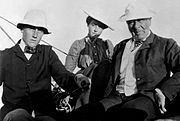

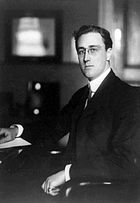
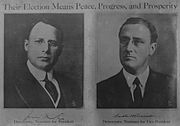
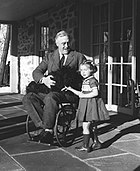
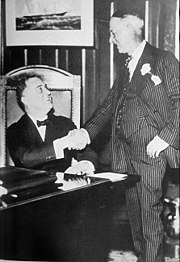
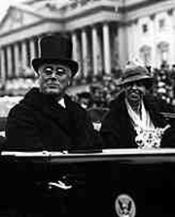
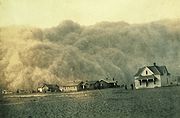


No comments:
Post a Comment